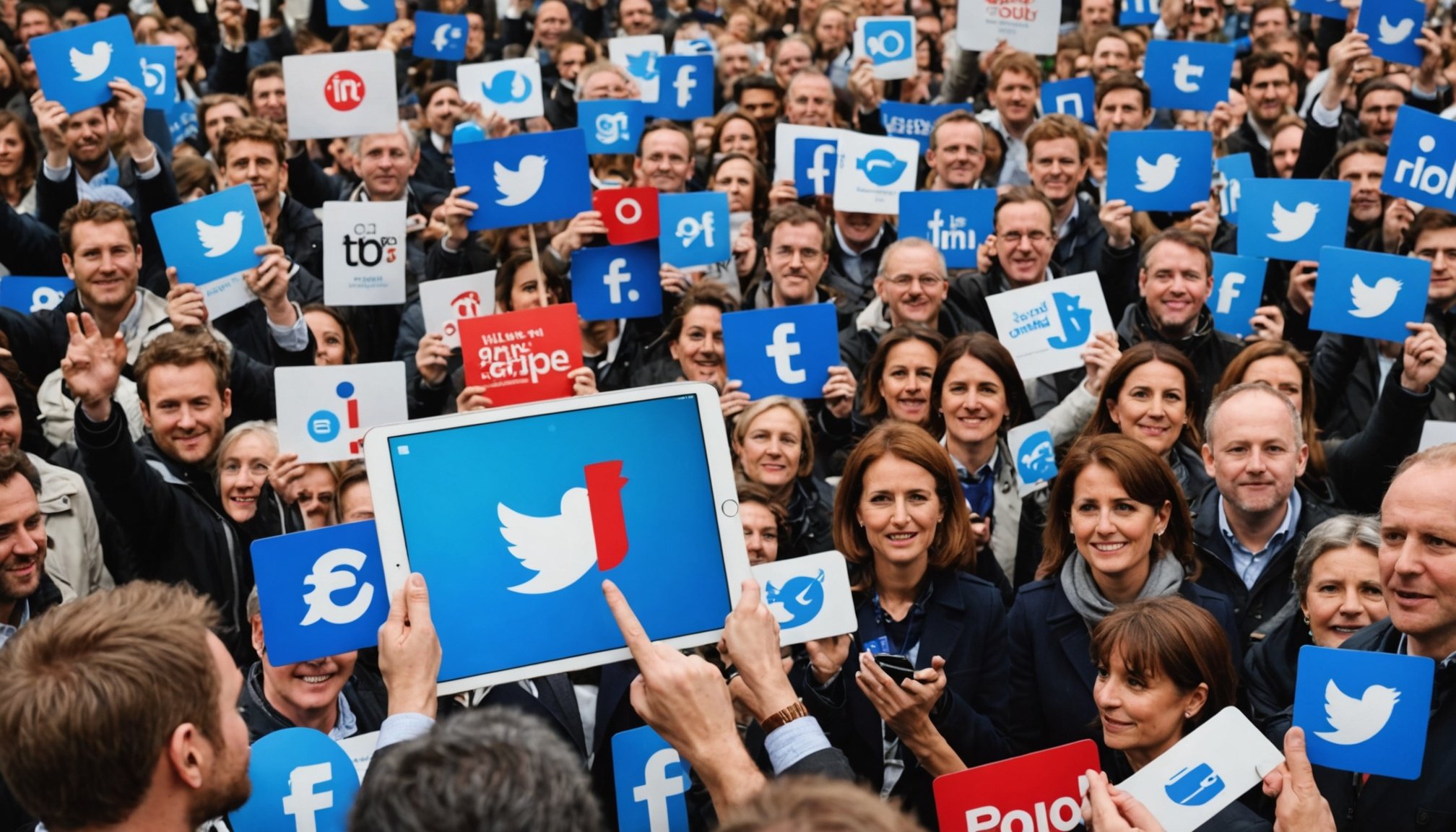Unleashing the Power of Social Media Analytics: Transforming Political Campaign Approaches in the UK
The Evolving Landscape of Political Campaigns
In the UK, the way political campaigns are conducted has undergone a significant transformation, largely driven by the advent and pervasive use of social media. What was once a realm dominated by traditional methods such as speeches, door knocks, and interviews has now expanded to include a robust online presence. Social media platforms, once thought to be the exclusive domain of younger voters, have become essential tools for reaching a broader demographic.
Tom Sneddon, managing partner at Supernova, part of Atomic London, notes: “Social isn’t an exclusively youth-oriented form of political campaigning. In fact, adults now spend an average of one to two hours a day online, giving campaigns a unique opportunity to reach people throughout the day in a way that feels familiar to them.”[1]
In parallel : Unlocking global expansion: essential scalability strategies for uk saas providers
The Role of Social Media in Political Campaigns
Social media has become a battleground for political influence, with platforms like Twitter (now X), Facebook, Instagram, and TikTok playing crucial roles. Here are some key ways social media is transforming political campaigns:
Micro-Targeting and Personalized Messaging
- Data-Driven Campaigns: Social media platforms provide extensive data analytics that allow campaigns to micro-target voters based on their personal data, interests, and behavior. This hyper-targeting enables campaigns to tailor messages to specific individuals, increasing the effectiveness of their outreach[1].
- Example: In the 2020 US elections, micro-targeting was used extensively to sway voters. This tactic is now being adopted in UK political campaigns to reach voters with personalized messages.
The Rise of AI-Generated Content
- Deepfakes and Misinformation: The emergence of AI-generated content, such as deepfakes, poses new challenges. These fabricated videos can appear terrifyingly real, making it difficult for voters to distinguish fact from fiction. This has significant implications for election integrity and public trust[1][4].
- Example: During the recent US presidential election, AI-generated content was used to spread false claims about election processes, contributing to a febrile atmosphere of distrust.
The Importance of Transparency and Regulation
- Disclosure of Political Ads: Experts suggest that making social media platforms disclose all political ads, including details about the sponsoring organization or individual, could help users understand the interests behind the messaging they see. This transparency is crucial in combating misinformation[1][3].
- Example: The Institute for Strategic Dialogue (ISD) found that despite policies to prevent the spread of false claims, social media platforms like Meta, X, and Google allowed ads that undermined election integrity. This highlights the need for stricter regulation and enforcement[3].
Leveraging Social Media Analytics for Campaign Success
Social media analytics is a powerful tool that can significantly enhance the effectiveness of political campaigns. Here’s how campaigns can leverage these analytics:
Have you seen this : Unlocking the future of predictive maintenance in the uk energy sector: leveraging machine learning innovations
Understanding Public Sentiment
- Sentiment Analysis: By analyzing social media posts, comments, and engagement metrics, campaigns can gauge public sentiment towards various issues and candidates. This helps in tailoring messages that resonate with the public[4].
- Example: Cint’s recent studies showed that 90% of U.S. respondents expressed worry about AI-fueled misinformation. This sentiment analysis can guide campaigns to address these concerns directly.
Identifying Key Influencers and Platforms
- Platform Preferences: Different age groups prefer different social media platforms. For instance, TikTok is highly influential among Gen Z, while older generations rely more on Facebook and YouTube. Understanding these preferences helps campaigns focus their efforts on the right platforms[4].
- Example: In the UK, Instagram, Facebook, and TikTok are the most important news sources for 16-24 year olds, while those aged 55 and above rely more on television news.
Content Creation and Engagement
- Engaging Content: Social media analytics can help campaigns create content that resonates with their audience. By analyzing engagement metrics such as likes, shares, and comments, campaigns can refine their content strategy to maximize user engagement[2].
- Example: Candidates who engage with meme culture on social media are more likely to influence Gen Z and Millennial voters. This underscores the importance of adapting content to the platform and audience.
Key Strategies for Political Parties
Here are some key strategies that political parties in the UK can adopt to effectively use social media analytics:
Collaborate with Creators
- Influencer Partnerships: Partnering with social media creators can help political parties connect with voters, especially younger demographics. This collaboration can make political messages more relatable and engaging[2].
- Example: In the upcoming UK general election, political parties are leveraging TikTok creators to sway voters through engaging and relatable content.
Invest in Fact-Checking
- Independent Fact-Checkers: Funding independent third-party fact-checkers can help verify claims made on social media in real time. This can flag misleading content and maintain the integrity of political discourse[1].
- Example: ISD’s research highlighted the failure of social media platforms to enforce policies against false claims. Independent fact-checkers can fill this gap.
Enhance Transparency and Regulation
- Regulatory Measures: Implementing legislation to ensure transparency in political ads and to prevent the misuse of personal data for micro-targeting is crucial. This can include making social media platforms disclose all political ads and their sponsors[1][3].
- Example: The ASA (Advertising Standards Authority) could play a role in regulating political ads, ensuring they adhere to the same standards as commercial ads.
Practical Insights and Actionable Advice
For political parties looking to harness the power of social media analytics, here are some practical insights and actionable advice:
Understand Your Audience
- Demographic Analysis: Use social media analytics to understand the demographics of your audience. This includes age, location, interests, and behavior. Tailor your messages accordingly to maximize impact.
- Example: A campaign targeting younger voters might focus on TikTok and Instagram, while a campaign targeting older voters might use Facebook and YouTube.
Monitor and Adapt
- Real-Time Analytics: Use real-time analytics to monitor the performance of your content and adjust your strategy accordingly. This includes tracking engagement metrics, sentiment analysis, and the effectiveness of different types of content.
- Example: If a particular type of content is not performing well, analyze the feedback and adjust the content to better resonate with the audience.
Ensure Transparency
- Disclosure and Regulation: Ensure that all political ads are transparent about their sponsors and adhere to regulatory standards. This builds trust with the public and maintains the integrity of the electoral process.
- Example: Disclose the funding sources of political ads and ensure that they comply with civic integrity policies.
Table: Comparative Analysis of Social Media Platforms for Political Campaigns
| Platform | Key Features | Target Audience | Engagement Metrics | Challenges |
|---|---|---|---|---|
| TikTok | Short-form videos, meme culture | Gen Z, Millennials | Likes, shares, comments | Misinformation, lack of transparency |
| Long-form content, groups, ads | Broad demographic, older generations | Likes, shares, comments, ad engagement | Data privacy concerns, misinformation | |
| Twitter (X) | Real-time updates, hashtags | Politicians, journalists, activists | Retweets, likes, replies | Misinformation, deepfakes, toxic interactions |
| Visual content, stories, reels | Younger demographics, visually-oriented audience | Likes, comments, story engagement | Misinformation, influencer authenticity | |
| YouTube | Long-form videos, live streams | Broad demographic, older generations | Views, likes, comments, watch time | Misinformation, algorithmic bias |
The use of social media analytics in political campaigns is a double-edged sword. While it offers unparalleled opportunities for targeted messaging and engagement, it also poses significant challenges such as misinformation, deepfakes, and the misuse of personal data. To ensure that social media remains a tool for democratic engagement rather than manipulation, it is crucial for political parties, governments, and social media platforms to collaborate on transparency, regulation, and fact-checking.
As Tom Sneddon concludes, “Ultimately, because this issue goes to the heart of our democracy, I would argue it’s the political parties that need to take the all-important first step and agree to be held to the same standards that society expects from advertisers.”[1]
By embracing innovation, leveraging data-driven strategies, and ensuring transparency and regulation, political campaigns in the UK can harness the power of social media to engage voters, build trust, and maintain the integrity of the democratic process.






